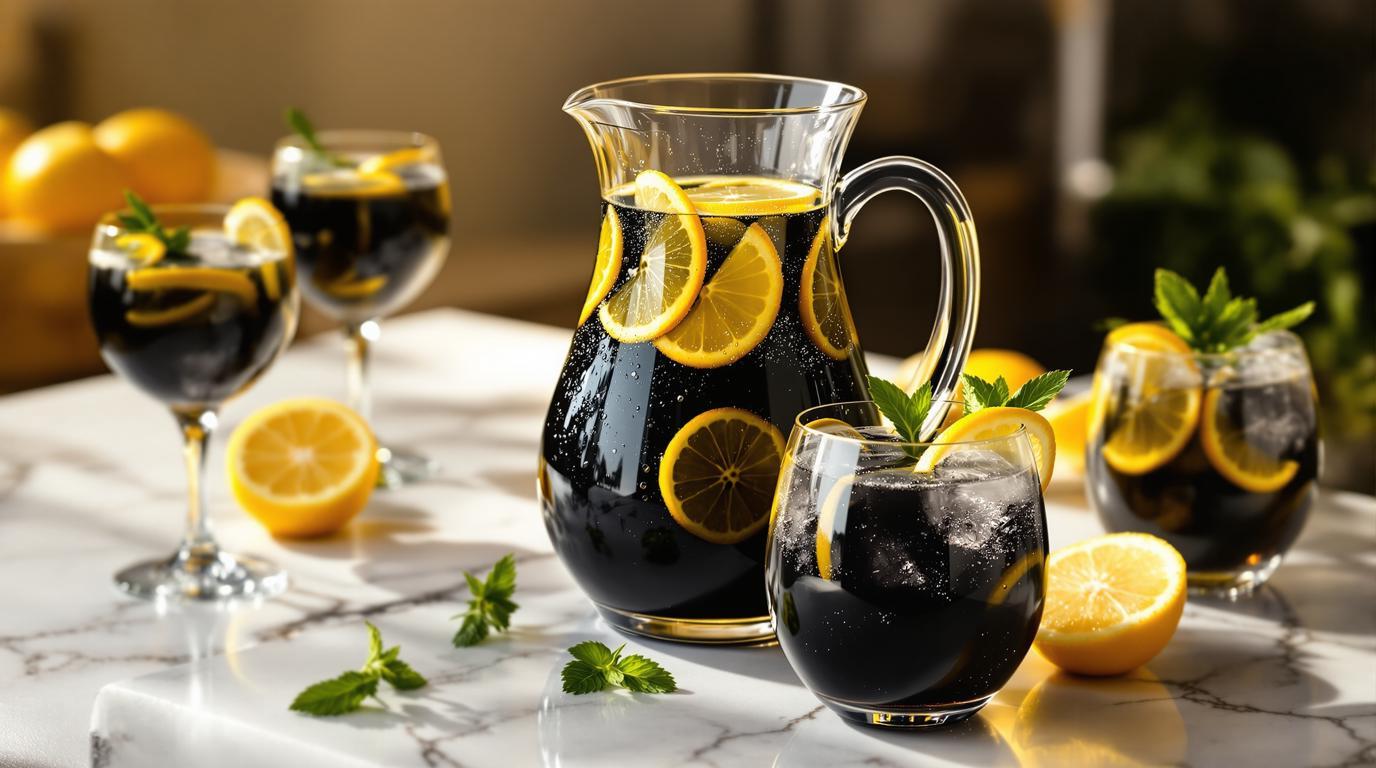The first time I made charcoal lemonade in my restaurant’s experimental kitchen, the entire staff gathered around with expressions ranging from curiosity to outright skepticism. The striking obsidian color against the bright citrus aromatics created such a sensory contradiction that we couldn’t help but be intrigued. While activated charcoal has been used medicinally for centuries, its emergence in culinary applications is relatively recent – but the technique of balancing its subtle earthiness with bright citrus creates something truly remarkable that honors both tradition and innovation. 🖤🍋
The Magic Behind Charcoal Lemonade 📖
Long before activated charcoal became trendy in wellness circles, it was a staple in traditional medicine across cultures. Ancient Ayurvedic and Greek practitioners used charcoal for its purifying properties. What we’re creating today bridges this ancient wisdom with modern culinary sensibilities – a refreshing detox drink that’s both visually striking and delicately balanced in flavor.
During my travels through Southeast Asia, I encountered various medicinal drinks that utilized activated charcoal, but it was a small wellness café in Bali that showed me how beautiful the marriage of bright citrus and earthy charcoal could be. Their approach inspired this recipe, which I’ve refined over countless iterations in my home kitchen. 🌏✨
Essential Ingredients 🧾
The beauty of this recipe lies in its simplicity – just four key ingredients that create something extraordinary:
- Fresh Lemon Juice: ½ cup (120ml) – approximately 2 large lemons
- Food-Grade Agave: ¼ cup (60ml) – lighter than honey but with more character than simple syrup
- Filtered Water: 3 cups (720ml) – the purity of your water matters tremendously here
- Food-Grade Activated Charcoal: 1 teaspoon (4g) – never substitute with non-food-grade charcoal
Chef’s Note: The quality of your lemons makes all the difference. Look for fruits that feel heavy for their size and have a slight give when gently squeezed – these will yield the most juice. I prefer Meyer lemons when in season for their natural sweetness and complexity, but standard lemons work beautifully year-round.
Step-by-Step Instructions 📝
- Prepare the citrus base: In a glass pitcher (charcoal can stain plastic), combine fresh lemon juice and agave. Whisk until the sweetener is completely dissolved – this patience ensures even sweetness throughout.
- Add your water: Pour in filtered water and stir gently to combine. The clarity of this mixture is your foundation.
- Incorporate the charcoal: This is where technique matters deeply. Add the activated charcoal powder gradually, whisking continuously to prevent clumping. Continue whisking for about 2-3 minutes to ensure proper integration.
- Rest and chill: Allow the mixture to rest for 5 minutes, then stir once more before refrigerating for at least 15 minutes. This resting period allows the flavors to harmonize while the temperature drops.
Chef’s Secret Techniques 🤫
The key to exceptional charcoal lemonade lies in understanding its behavior. Unlike most ingredients, activated charcoal has a tendency to settle rapidly. I always keep a small whisk tableside and give each serving a gentle stir just before sipping. This maintains the dramatic color throughout and prevents that unpleasant gritty texture that can develop when the charcoal settles at the bottom. 💡
For those concerned about the subtle earthy notes, I’ve found that adding a small sprig of mint or a few drops of vanilla extract creates fascinating complexity that draws attention away from any mineral qualities the charcoal might impart. Both additions work beautifully with the bright citrus backdrop.
If you’re looking for substitutions, maple syrup can replace agave for a deeper, more complex sweetness. For those avoiding sweeteners altogether, a few drops of liquid stevia combined with kombucha creates a fascinating probiotic variation.
Serving & Presentation Tips 🍽️
The dramatic black color against a clear glass creates an unforgettable visual presentation. I serve mine in stemless wine glasses with a thin slice of lemon floating on top – the bright yellow against the obsidian background is simply stunning. For special occasions, consider freezing edible flowers in ice cubes to add another dimension of visual interest.
This refreshing detox drink pairs wonderfully with light, fresh appetizers like Caprese skewers or vegetarian sushi rolls. For a complete refreshment experience, consider serving alongside a watermelon punch for guests who might be hesitant about the charcoal.
Remember that timing matters with charcoal beverages – ideally consume on an empty stomach, at least 2 hours before or after medications, as charcoal can bind to certain compounds. And always follow with plenty of water to maintain hydration.
The true beauty of charcoal lemonade lies in its balance – visually dramatic yet subtly flavored, modern in appearance yet connected to ancient wellness traditions. Like grandmother’s biscuit-folding technique, sometimes the most memorable culinary experiences come from honoring tradition while embracing innovation. May your kitchen adventures always be as bold and beautiful as this striking obsidian elixir. 🖤✨
